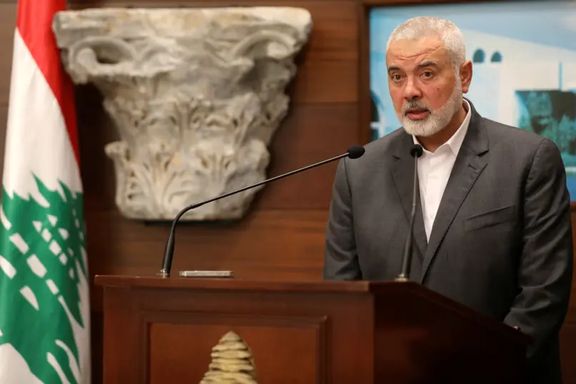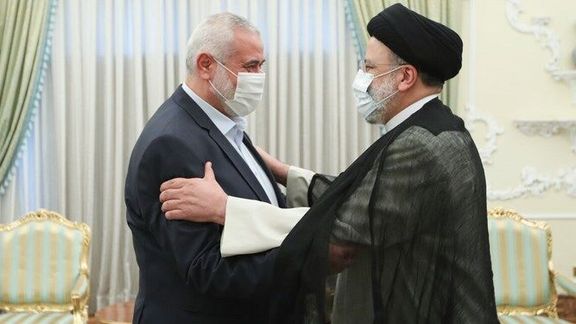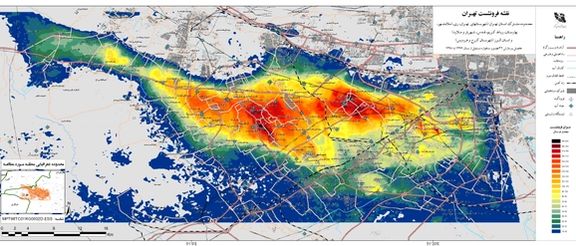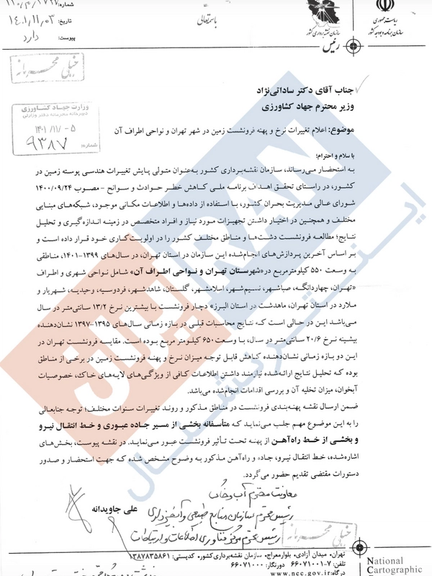Iran’s President Arrives In Syria After Regional Power Shifts

Iranian President Ebrahim Raisi landed in Damascus on Wednesday for talks with his Syrian counterpart Bashar al-Assad, media in Tehran and Damascus reported.

Iranian President Ebrahim Raisi landed in Damascus on Wednesday for talks with his Syrian counterpart Bashar al-Assad, media in Tehran and Damascus reported.
This is the first visit by an Iranian head of state since civil war broke out in Syria in 2011.
With military and economic support from both Iran and Russia, Assad regained control of most of Syria from rebels, using at times indiscriminate military force.
Raisi's visit comes as Iran and regional rival Saudi Arabia rebuild ties after years of tensions. Arab nations which had isolated Syria over its crackdown against protests in 2011 are developing a roadmap to end the 12-year war and reintegrate Syria into the Arab fold.
Speaking to pro-Iran broadcaster al-Mayadeen on the eve of his visit, Raisi said the trip would "consolidate and develop" ties with Syria and other allies, including Lebanese armed group Hezbollah, which also intervened in Syria on Assad's behalf.
Iranian and Syrian flags lined the airport road on Wednesday in preparation for the arrival of Raisi and his accompanying delegation, which includes Iran's ministers of oil, defense, foreign affairs and telecommunications.
Syrian state media said "a number of agreements" would be signed during the two-day visit.
Tehran hopes to expand its economic footprint in Syria, although itself faces a serious financial crisis partly due to US sanctions.
In parallel, it has become even more entrenched militarily. An Israeli rocket strike on Damascus in February killed Iranian military experts and Tehran has used the flow of aid in the aftermath of the deadly February earthquake to bring in arms.

Iranian media say the government’s plan to lease historically important buildings for business development is tantamount to “auctioning off Iranian heritage”.
“What will the role of the government be in preserving the country’s historical heritage if the ministry … grants the lease of all historical sites for business development,” reformist Sazandegi newspaper wrote in an article Tuesday, entitled “Auctioning Off Iranian Heritage: A Report on the Auction of 19 Historical Buildings”.
“Should we expect Persepolis, the tombs of [national poets] Hafez and Sa’adi [Shirazi] and the Naghsh-e Jahan Square [in Isfahan] to be also put on offer for business development?” Sazandegi asked.
The plan was disclosed last week by the semi-official Iranian Students News Agency (ISNA) which provided the names of the 19 culturally and historically significant buildings on the auction list of the cultural heritage, tourism, and handicrafts ministry.
Ehsan Dehghani, an official of the ministry, told ISNA that the auction for granting the leases for business development projects, such as turning them into hotels and restaurants, will be held by the ministry on May 22.
One of the most significant buildings on the list is the Rayen Castle, an adobe castle in Kerman Province which is believed to be 1,000 years old, possibly with much older foundations dating to pre-Islamic times.
Another building on the list is the country residence of Nasereddin Mirza, a Qajar prince. The building was confiscated from the prince’s heirs, like many other buildings owned by members of the Pahlavi and Qajar dynasties, following the Islamic Revolution of 1979 and is owned by the government now.

The plan is part of the massive scheme of President Ebrahim Raisi’s government to liquidate public assets. A seven-man team endorsed by Supreme Leader Ali Khamenei are responsible for the implementation of the scheme with full legal immunity for the consequences of their work. The team is headed by Vice President Mohammad Mokhber, who practically runs the administration and is closely linked with Khamenei’s office.
The Raisi administration decided to sell public properties in November 2022 to raise money amid financial crisis and a large budget deficit to keep itself afloat.
The shady privatization plan, which is promulgated as ways to improve the generation of wealth and production in Iran, has been met with skepticism by the public, who have witnessed corrupt “privatization” in the past 15 years, when state properties were sold at ridiculously low prices to well-connected individuals.
In May 2020, many archaeologists and ordinary Iranians strongly objected to a motion by 46 lawmakers to legalize private archeological excavation and trade in ancient artifacts and antiques in the parliament to legalize private archeological excavation and trade of ancient artifacts and antiques.
Critics said the plan was prepared without any consultations with expert organizations such as the Research Institute of Cultural Heritage and Tourism, the Society of Iranian Archeologists, or the Archeology Taskforce of the Ministry of Science and is in contradiction to several existing laws, which regulate archeological excavation and trade in items of historical value.
Privatizing excavation and legalizing trade would deprive the country's own museums, which would not be able to compete with private buyers, and deprive them of any future findings, a group of prominent archaeologists said in a letter to Parliament Speaker Mohammad-Bagher Ghalibaf.
Archeologists also argued that approval of the motion could result in inexperienced excavators damaging archeological sites and their contents as well as lack of proper reporting of information related to the excavation sites, which are of great significance to historians and archeologists.

Britain has not issued invitations to King Charles' coronation to the leaders of Russia, Belarus, Iran, Myanmar, Syria, Afghanistan and Venezuela, a British source said on Tuesday.
Heads of state from other nations with whom Britain has full diplomatic ties were invited, as were representatives of British realms and overseas territories. Invitations were issued to senior diplomats, rather than heads of state, for North Korea and Nicaragua.
Reuters quoted UK sources as saying that Iran, and the other countries seen as pariah states have not been invited to the historic event.
The United Kingdom, along with the European Union and the United States have issued a series of sanctions against Iran since September 2022 for human rights violations and weapons transfers.
Iranian security forces killed more than 500 civilians and arrested more than 20,000 after anti-regime protests broke out last year over the killing of a young woman, Mahsa, Amini in 'hijab police' custody.
Iran has also been sending killer drones and reportedly other weapons to Russia that have been used against civilian targets in Ukraine.
There are demands among British lawmakers and the Iranian community to fully proscribe the Revolutionary Guard as a terrorist group, mainly for their role in the bloody suppression of protests and their support for terror groups in the Middle East.
With reporting by Reuters

Iran International has learned that Palestinian militant group Hamas pressured the Islamic Republic into inviting its leader to Tehran hoping to get financial support.
According to our sources, the official invitation of Hamas leader Ismail Haniyeh was made following numerous requests because the Palestinian group is struggling with financial problems.
Haniyeh is expected to visit Iran in the near future, the Gaza-based terror group announced last Friday, April 28. Haniyeh's visit will be in relation to “political and field developments,” Hamas said, with Haniyeh expressing thanks and appreciation for the call, confirming his acceptance of the invitation and his intention to go to Tehran soon.
Iran International’s sources claimed that Hamas’ assets have been confiscated in several countries and currently the channels through which the group could receive aid in cryptocurrencies such as Bitcoin are also blocked. Therefore, the group sees the Islamic Republic as among its few sources of income.

The sources added that although the Islamic Republic continues to provide financial aid to Hamas despite its own economic situation, Tehran is not satisfied with the performance of this group against Israel and is unlikely to give more aid to this group.
In December, Palestinian Arabic language daily newspaper Al-Quds cited informed sources in Lebanon as saying that the Islamic Republic had cut off its financial support for some Palestinian groups, without specifying which groups. General belief is that the Palestinian Islamic Jihad Movement, Hamas and the Popular Front for the Liberation of Palestine were the main recipients of financial aid from the Islamic Republic, among which Hamas and Islamic Jihad are known to be receiving the lion’s share of Tehran’s aid.

According to Al-Quds sources, these groups depend on Iran's financial aid to pay the salaries of their leaders and members as well as the expenses for other activities. The Islamic Republic’s cutting off aid caused serious problems both in the Gaza Strip and outside the Palestinian territories, to the extent that in some cases, these groups and their leaders have not been able to pay their utility bills, the paper reported.
In March 2022, Haniyeh revealed that the Islamic Republic paid a total of $70 million to Hamas to help it develop missiles and defense systems.
During an interview with Al-Jazeera, Haniyeh said different countries help in financing the group, but Iran is the biggest donor. The head of Hamas political bureau added that thanks to the aid from Iran, his group managed to have a comprehensive defense strategy in its confrontation with the Israeli military in the Gaza Strip in 2021.
He was referring to the two-week outbreak of violence in May 2021 that was called operation “Sword of Jerusalem” by Hamas but dubbed operation “Guardian of the Walls” by Israel. Hamas reportedly fired more than 4,000 rockets and missiles at Israel, most of which were intercepted by the Israeli Iron Dome defense system.
Haniyeh added that Iran backs the Shiite groups within its framework of support for the “axis of resistance” in the region – a term used by Tehran for its aligned militia forces -- noting that Tehran also supports Sunni movements against Israel.
Following normalization of its ties with Iran and Syria, Saudi Arabia also invited a senior delegation of Hamas to the kingdom in April. With China's mediation, Saudi Arabia normalized ties with Iran on March 10 and returned its relations with Syria to the level before the Syrian war. The Saudi embassies in Iran and Syria are scheduled to reopen in the coming weeks.
The Hamas-affiliated al-Resalah newspaper wrote said at the time that Haniyeh, and the head of Hamas Diaspora Office Khaled Mashaal, who have been living in Qatar in the past years, traveled to Riyadh at the head of a high-level delegation. In recent years, relations between Hamas and Saudi Arabia have been tense, with the Kingdom detaining some members of the group, accusing them of supporting terrorism. The tensions mounted as Hamas drew closer to the Islamic Republic.
In December, Lebanese media reported that Hezbollah is also facing financial problems due to the situation in Iran, as it cannot import Iranian goods to sell at a discount to its supporters.
Israeli Foreign Minister Eli Cohen earlier in the year that “Iran is like a cancer. It finances Hamas, the Jihad, and Hezbollah.” Late in April, Iran’s Foreign Minister Hossein Amir-Abdollahian met with heads of two of the regime's terror proxies -- Hezbollah and Palestinian Islamic Jihad Movement -- during a visit to Lebanon.

Iranian prominent activist Masih Alinejad said at the UN that the leaders of Iran are the biggest oppressors of media freedom in the world.
On the occasion of the World Press Freedom Day, Alinejad told the UN General Assembly that she comes from a country where being a journalist is considered a crime and causes people to be imprisoned.
UNESCO has planned two major events in New York, including a global conference at the United Nations headquarters, to commemorate the 30th edition of World Press Freedom Day.
She further talked about the threats of the Islamic Republic against Iran International and other Farsi-language London-based media, saying that she proposes a resolution in this regard to condemn the international repressions of the Iranian regime.
Speaking about the Islamic Republic's fear of social networks, she added that Supreme LeaderAli Khamenei has restricted social media for people, but the government officials have accounts on the networks.
“I held up a picture of Mahsa Amini from the very same podium that butcher Ebrahim Raisi raised a picture of terrorist Qasem Soleimani in September. The picture of Mahsa Amini represents the real Iran. Raisi and Soleimani do not,” she said in a tweet.
The Islamic Republic through its propaganda tries to show ex-IRGC commander Qassem Soleimani as a national hero, but many people believe he was guilty of war crimes against civilians in Syria and spreading violence across the region.
She also slammed the imprisonment of Elaheh Mohammadi and Niloufar Hamedi, two journalists who reported the murder and funeral of Mahsa Amini, the 22-year-old Kurdish who was killed in police custody in September.

Iran International has obtained documents revealing that Iranian officials are aware of dangerous land subsidence but are unwilling to share it with the public.
On Saturday, Iran International television released its exclusive report about the issue, leaking a confidential letter from the country’s National Cartographic Center addressed to former agriculture minister Javad Sadatinejad, who was removed by President Ebrahim Raisi mid-April without announcing any concrete reasons.
In the letter, Ali Javidaneh an official at the center says that about 550 square kilometers of land in and around the capital Tehran (about the size of the UK city of Manchester or the US city of El Paso, Texas)is sinking an average of over 13 centimeters (about 5.12 inch) per year.
He said that parts of critical infrastructures in the area are affected by subsidence, adding that parts of the highway and the area’s power transmission lines as well as part of the railway pass through the affected areas.
According to another document with details about land subsidence across the country, 380 cities and towns and 9,200 villages are at risk of land subsidence and in some cases the entire area of the cities are located in the subsidence zones.

According to the data in the report,which was not made available to the public either, almost all the provinces of the country are affected by the issue. Bahreman, a city in the central province of Kerman, is on top of the list with 42 centimeters (about 1.38 ft) subsidence per year.
A day after the Iran International’s report, the National Cartographic Center unveiled a map of the country’s land subsidence during a geomatics event in Tehran.
Confirming our report, MasomehAmighpey, an official of the center, was cited by state media as saying that "In the assessments, we identified 245 subsidence prone areas, 30% of which have a high rate of subsidence." She added that 14 metropolises of the country are affected by land subsidence, and according to the statistics of the Energy Ministry, 70% of the country's plains are in crisis due to mismanagement.
Land subsidence is not limited to big cities with big construction projects. In many areas in Iran cracks and huge hollows that resemble meteor craters have appeared in the ground in recent years.
Experts say that over-extraction of ground water has led for cavities being formed underground which in turn lead to subsidence.
According to a report in March, the current level of land subsidence in Iran is “critical", with experts claiming it puts the lives of more than 39 million people at risk, about half of the country’s population.
Several factors have caused the situation to reach breaking point, including dam construction, climate change, inefficient water consumption by agriculture and industries, and the use of underground aquifers as sources for illegal agricultural water extraction wells.
Ali Beitollahi, heading the disaster task force on the issue at the Road, Housing and Urban Development Research Center of Iran, said the approximate area of subsidence zones in the country is now 18.5 million hectares, almost 11% of Iran's total area.
However, international reports claim the danger is even worse, nearing a humanitarian crisis. Science journal claims that more than 98% of Iran's 1.648 million km of land faces land subsidence.
Internationally, a rate of subsidence greater than 4mm (about 0.16 in) per year is considered a crisis and yet Iran's land is sinking at an astonishing rate of 6cm (about 2.36 in) per year in average as a result of 25 years of water level decline in the plains.
Ground subsidence in urban areas has resulted in power outages, bursting of gas pipes, deformation of rails, emergence of sinkholes, tilting of buildings, the appearance of cracks and ditches in roads and even loss of human life.Continued water level declines will reduce the ground's water permeability and turn fertile plains into barren deserts.